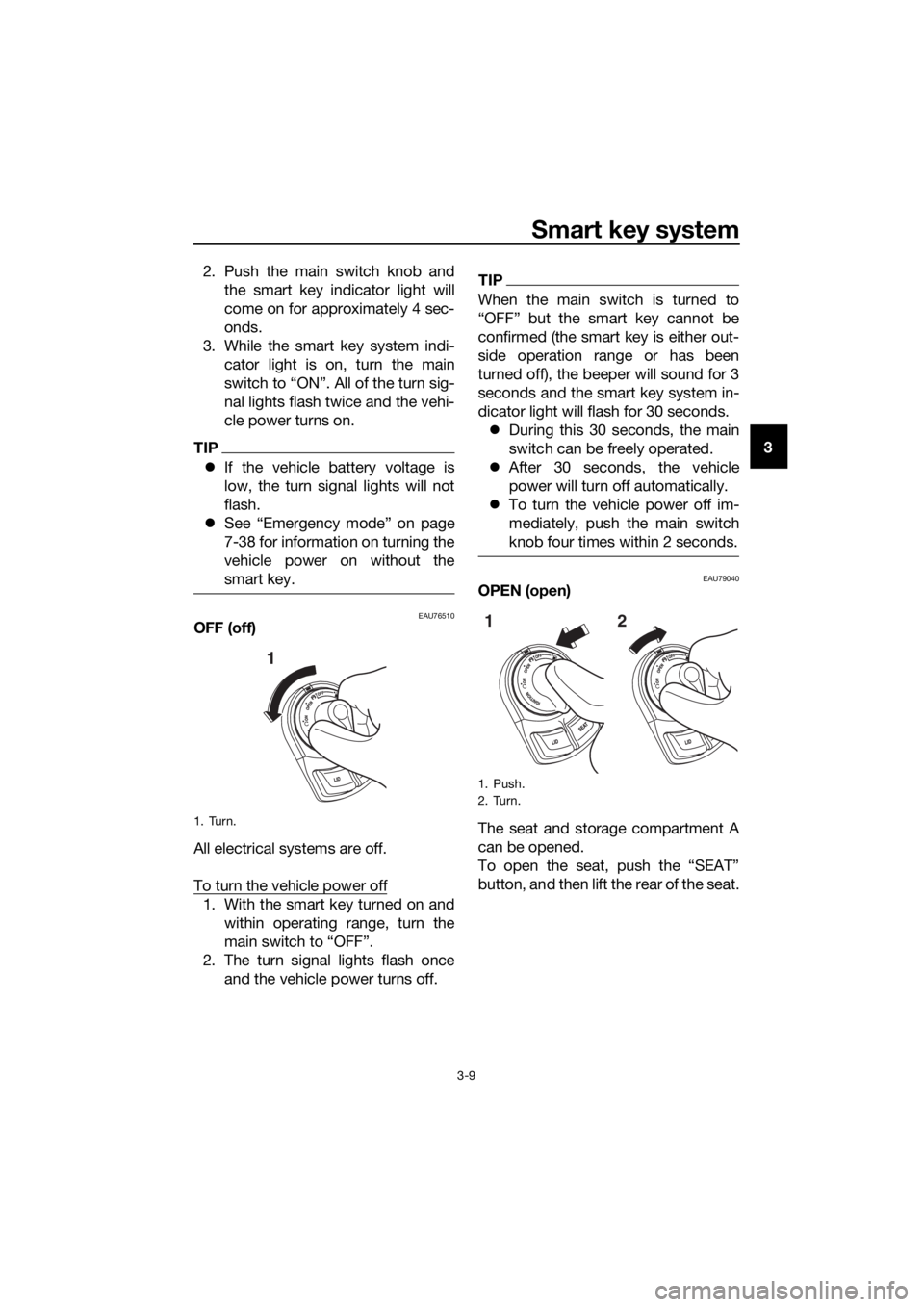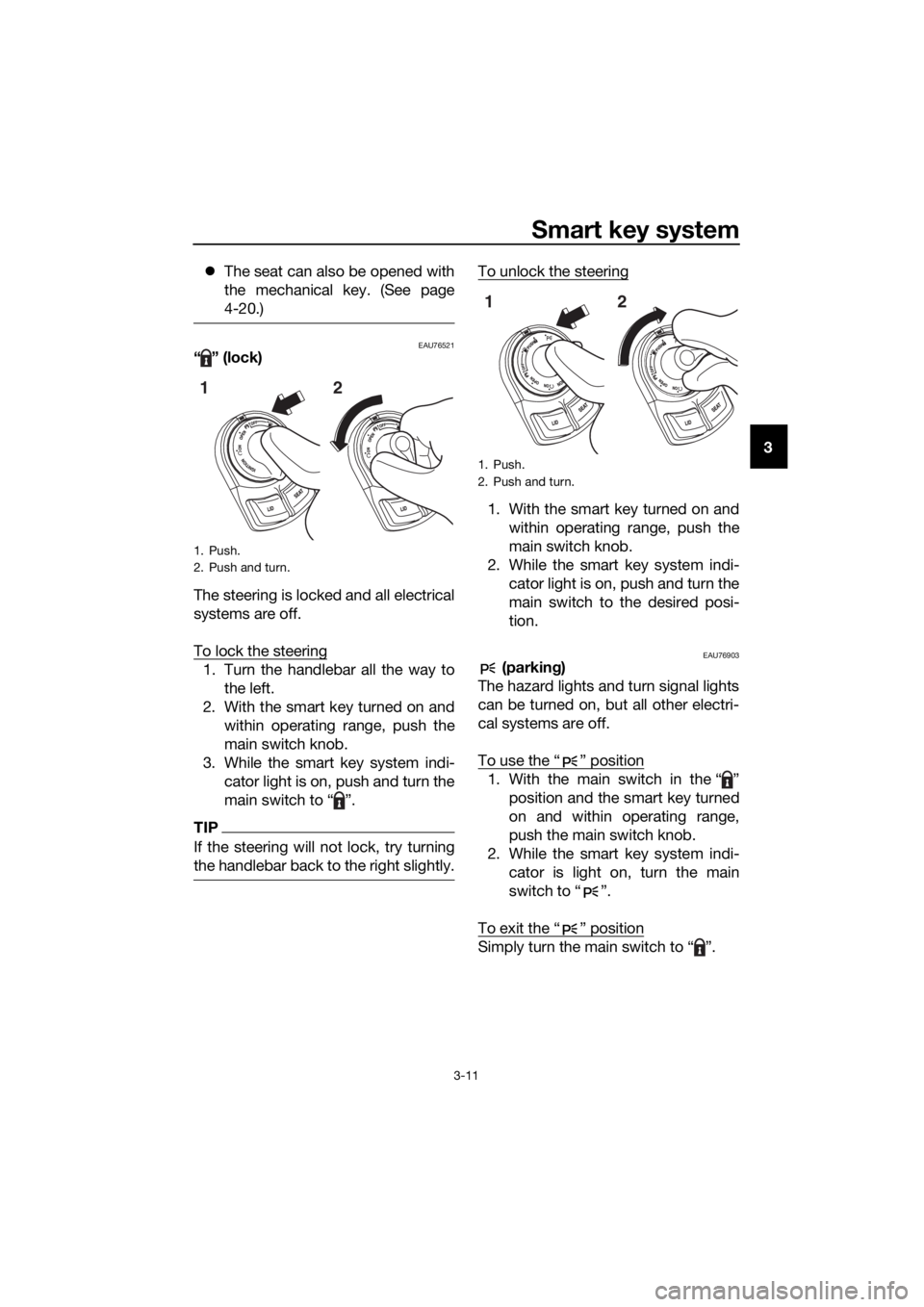2017 YAMAHA XMAX 300 turn signal
[x] Cancel search: turn signalPage 6 of 116

Table of contents
Lubricating the front and rear
brake levers ............................... 7-26
Checking and lubricating the centerstand and sidestand ....... 7-27
Checking the front fork................. 7-27
Checking the steering................... 7-28
Checking the wheel bearings ....... 7-28
Battery .......................................... 7-29
Replacing the fuses ...................... 7-30
Headlights .................................... 7-32
Auxiliary lights............................... 7-32
Brake/tail light............................... 7-33
Front turn signal light.................... 7-33
Rear turn signal light bulb............. 7-34
Replacing the license plate light
bulb ........................................... 7-34
Troubleshooting............................ 7-35
Troubleshooting charts................. 7-36
Emergency mode ........................ 7-38
Scooter care an d stora ge ............... 8-1
Matte color caution ........................ 8-1
Care ................................................ 8-1
Storage ........................................... 8-4
Specifications ................................... 9-1
Consumer information ................... 10-1
Identification numbers .................. 10-1
Diagnostic connector ................... 10-2
Vehicle data recording.................. 10-2
In dex ................................................ 11-1
UB74E0E0.book Page 2 Tuesday, May 2, 2017 1:04 PM
Page 8 of 116

Safety information
1-2
1• Know your skills and limits.
Staying within your limits may
help you to avoid an accident.
• We recommend that you prac- tice riding your scooter where
there is no traffic until you have
become thoroughly familiar with
the scooter and all of its con-
trols.
�z Many accidents have been
caused by error of the scooter op-
erator. A typical error made by the
operator is veering wide on a turn
due to excessive speed or under-
cornering (insufficient lean angle
for the speed).
• Always obey the speed limit and never travel faster than warrant-
ed by road and traffic condi-
tions.
• Always signal before turning or changing lanes. Make sure that
other motorists can see you.
�z The posture of the operator and
passenger is important for proper
control.
• The operator should keep both hands on the handlebar and
both feet on the operator foot-
rests during operation to main-
tain control of the scooter.
• The passenger should always hold onto the operator, the seat
strap or grab bar, if equipped,
with both hands and keep both
feet on the passenger footrests.
Never carry a passenger unless
he or she can firmly place both
feet on the passenger footrests.
�z Never ride under the influence of
alcohol or other drugs. �z
This scooter is designed for on-
road use only. It is not suitable for
off-road use.
Protective Apparel
The majority of fatalities from scooter
accidents are the result of head inju-
ries. The use of a safety helmet is the
single most critical factor in the pre-
vention or reduction of head injuries. �z Always wear an approved helmet.
�z Wear a face shield or goggles.
Wind in your unprotected eyes
could contribute to an impairment
of vision that could delay seeing a
hazard.
�z The use of a jacket, substantial
shoes, trousers, gloves, etc., is ef-
fective in preventing or reducing
abrasions or lacerations.
�z Never wear loose-fitting clothes,
otherwise they could catch on the
control levers or wheels and cause
injury or an accident.
�z Always wear protective clothing
that covers your legs, ankles, and
feet. The engine or exhaust sys-
tem become very hot during or af-
ter operation and can cause
burns.
�z A passenger should also observe
the above precautions.
Avoi d Car bon Monoxi de Poisonin g
All engine exhaust contains carbon
monoxide, a deadly gas. Breathing
carbon monoxide can cause head-
aches, dizziness, drowsiness, nausea,
confusion, and eventually death.
Carbon Monoxide is a colorless, odor-
less, tasteless gas which may be pres-
ent even if you do not see or smell any
UB74E0E0.book Page 2 Tuesday, May 2, 2017 1:04 PM
Page 11 of 116

Safety information
1-5
1
Aftermarket Tires an
d Rims
The tires and rims that came with your
scooter were designed to match the
performance capabilities and to pro-
vide the best combination of handling,
braking, and comfort. Other tires, rims,
sizes, and combinations may not be
appropriate. Refer to page 7-19 for tire
specifications and more information on
replacing your tires.
Transportin g the Scooter
Be sure to observe following instruc-
tions before transporting the scooter in
another vehicle. �z Remove all loose items from the
scooter.
�z Point the front wheel straight
ahead on the trailer or in the truck
bed, and choke it in a rail to pre-
vent movement.
�z Secure the scooter with tie-downs
or suitable straps that are at-
tached to solid parts of the scoot-
er, such as the frame or upper
front fork triple clamp (and not, for
example, to rubber-mounted han-
dlebars or turn signals, or parts
that could break). Choose the lo-
cation for the straps carefully so
the straps will not rub against
painted surfaces during transport.
�z The suspension should be com-
pressed somewhat by the tie-
downs, if possible, so that the
scooter will not bounce exces-
sively during transport.
EAU57600
Further safe-ri din g points
�z Be sure to signal clearly when
making turns.
�z Braking can be extremely difficult
on a wet road. Avoid hard braking,
because the scooter could slide.
Apply the brakes slowly when
stopping on a wet surface.
�z Slow down as you approach a
corner or turn. Once you have
completed a turn, accelerate
slowly.
�z Be careful when passing parked
cars. A driver might not see you
and open a door in your path.
�z Railroad crossings, streetcar rails,
iron plates on road construction
sites, and manhole covers be-
come extremely slippery when
wet. Slow down and cross them
with caution. Keep the scooter up-
right, otherwise it could slide out
from under you.
�z The brake pads or linings could
get wet when you wash the scoot-
er. After washing the scooter,
check the brakes before riding.
�z Always wear a helmet, gloves,
trousers (tapered around the cuff
and ankle so they do not flap), and
a brightly colored jacket.
�z Do not carry too much luggage on
the scooter. An overloaded scoot-
er is unstable. Use a strong cord
to secure any luggage to the carri-
er (if equipped). A loose load will
affect the stability of the scooter
and could divert your attention
from the road. (See page 1-3.)
UB74E0E0.book Page 5 Tuesday, May 2, 2017 1:04 PM
Page 19 of 116

Smart key system
3-5
3
�z
You can register up to six smart
keys for the same vehicle. See a
Yamaha dealer regarding spare
smart keys.
�z If a smart key is lost, contact a
Yamaha dealer immediately to
prevent the vehicle from being
stolen.
EAU76471
Smart key
To turn the smart key on or off
Push the smart key button for approxi-
mately 1 second to turn the smart key
on or off. When the smart key is turned
off, the vehicle cannot be operated
even if the smart key is within operating
range. To operate the vehicle, turn the
smart key on and bring it within operat-
ing range.
To check whether the smart key is
turne d on or off
Push the smart key button to confirm
the current operating status of the
smart key.
If the smart key indicator light: �z Short flash (0.1 seconds): The
smart key is turned on.
�z Long flash (0.5 seconds): The
smart key is turned off.
Remote answer- back function
Push the smart key button to operate
the answer-back function remotely.
The beeper will sound twice and all of
the turn signal lights will flash twice.
1. Smart key indicator light
2. Smart key button
1
2
UB74E0E0.book Page 5 Tuesday, May 2, 2017 1:04 PM
Page 23 of 116

Smart key system
3-9
3
2. Push the main switch knob and
the smart key indicator light will
come on for approximately 4 sec-
onds.
3. While the smart key system indi- cator light is on, turn the main
switch to “ON”. All of the turn sig-
nal lights flash twice and the vehi-
cle power turns on.TIP
�zIf the vehicle battery voltage is
low, the turn signal lights will not
flash.
�z See “Emergency mode” on page
7-38 for information on turning the
vehicle power on without the
smart key.
EAU76510OFF (off)
All electrical systems are off.
To turn the vehicle power off
1. With the smart key turned on and
within operating range, turn the
main switch to “OFF”.
2. The turn signal lights flash once and the vehicle power turns off.
TIP
When the main switch is turned to
“OFF” but the smart key cannot be
confirmed (the smart key is either out-
side operation range or has been
turned off), the beeper will sound for 3
seconds and the smart key system in-
dicator light will flash for 30 seconds.�z During this 30 seconds, the main
switch can be freely operated.
�z After 30 seconds, the vehicle
power will turn off automatically.
�z To turn the vehicle power off im-
mediately, push the main switch
knob four times within 2 seconds.
EAU79040OPEN (open)
The seat and storage compartment A
can be opened.
To open the seat, push the “SEAT”
button, and then lift the rear of the seat.
1. Turn.
1
1. Push.
2. Turn.
1
2
UB74E0E0.book Page 9 Tuesday, May 2, 2017 1:04 PM
Page 25 of 116

Smart key system
3-11
3
�z
The seat can also be opened with
the mechanical key. (See page
4-20.)
EAU76521“ ” (lock)
The steering is locked and all electrical
systems are off.
To lock the steering
1. Turn the handlebar all the way to
the left.
2. With the smart key turned on and within operating range, push the
main switch knob.
3. While the smart key system indi- cator light is on, push and turn the
main switch to “ ”.
TIP
If the steering will not lock, try turning
the handlebar back to the right slightly.
To unlock the steering
1. With the smart key turned on andwithin operating range, push the
main switch knob.
2. While the smart key system indi- cator light is on, push and turn the
main switch to the desired posi-
tion.
EAU76903 (parkin g)
The hazard lights and turn signal lights
can be turned on, but all other electri-
cal systems are off.
To use the “ ” position
1. With the main switch in the “ ” position and the smart key turned
on and within operating range,
push the main switch knob.
2. While the smart key system indi- cator is light on, turn the main
switch to “ ”.
To exit the “ ” position
Simply turn the main switch to “ ”.
1. Push.
2. Push and turn.
1 2
1. Push.
2. Push and turn.
12
UB74E0E0.book Page 11 Tuesday, May 2, 2017 1:04 PM
Page 27 of 116

Instrument and control functions
4-1
4
EAU4939C
In dicator li ghts an d warnin g
li g hts
EAU11032Turn si gnal in dicator li ghts “ ”
an d“”
Each indicator light will flash when its
corresponding turn signal lights are
flashing.
EAU11081Hi gh beam in dicator li ght “ ”
This indicator light comes on when the
high beam of the headlight is switched
on.
EAU78180En gine trou ble warnin g lig ht “ ”
This warning light comes on if a prob-
lem is detected in the engine or other
vehicle control system. If this occurs,
have a Yamaha dealer check the on-
board diagnostic system. The electrical circuit of the warning
light can be checked by turning the
main switch to “ON”. The warning light
should come on for a few seconds, and
then go off.
If the warning light does not come on
initially when the main switch is turned
to “ON”, or if the warning light remains
on, have a Yamaha dealer check the
vehicle.
EAU78171ABS warnin
g lig ht “ ”
In normal operation, the ABS warning
light comes on when the main switch is
turned to “ON”, and goes off after trav-
eling at a speed of 10 km/h (6 mi/h) or
higher.
If the ABS warning light: �z does not come on when the main
switch is turned to “ON”
�z comes on or flashes while riding
�z does not go off after traveling at a
speed of 10 km/h (6 mi/h) or high-
er
The ABS may not work correctly. If any
of the above occurs, have a Yamaha
dealer check the system as soon as
possible. (See page 4-14 for an expla-
nation of the ABS.)
WARNING
EWA16041
If the ABS warnin g li ght does not go
off after travelin g at a speed of 10
km/h (6 mi/h) or hi gher, or if the
warnin g lig ht comes on or flashes
while ri din g, the b rake system re-
verts to conventional brakin g. If ei-
ther of the a bove occurs, or if the
warnin g lig ht does not come on at
all, use extra caution to avoi d possi-
b le wheel lock durin g emer gency
1. Left turn signal indicator light “ ”
2. Right turn signal indicator light “ ”
3. High beam indicator light “ ”
4. Anti-lock Brake System (ABS) warning
light “ ”
5. Engine trouble warning light “ ”
6. Traction control system indicator light “ ”
7. Smart key system indicator light “ ”
12
36745
ABS
ABS
UB74E0E0.book Page 1 Tuesday, May 2, 2017 1:04 PM
Page 38 of 116

Instrument and control functions
4-12
4
EAU1234M
Han dle bar switches
Left
Ri ght
EAU54201Dimmer/Pass switch “ / /PASS”
Set this switch to “ ” for the high
beam and to “ ” for the low beam.
To flash the high beam, push the pass
side “PASS” of the switch while the
headlights are on low beam.
EAU12461Turn si gnal switch “ / ”
To signal a right-hand turn, push this
switch to “ ”. To signal a left-hand
turn, push this switch to “ ”. When
released, the switch returns to the cen- ter position. To cancel the turn signal
lights, push the switch in after it has re-
turned to the center position.
EAU12501Horn switch “ ”
Press this switch to sound the horn.
EAU54212Stop/Run/Start switch “ / / ”
To crank the engine with the starter,
set this switch to “ ”, and then push
the switch down towards “ ”. See
page 6-2 for starting instructions prior
to starting the engine.
Set this switch to “ ” to stop the en-
gine in case of an emergency, such as
when the vehicle overturns or when the
throttle cable is stuck.
EAU78190Hazar
d switch “ ”
With the main switch in the “ON”
or “ ” position, use this switch to turn
on the hazard lights (simultaneous
flashing of all turn signal lights).
The hazard lights are used in case of an
emergency or to warn other drivers
when your vehicle is stopped where it
might be a traffic hazard.
NOTICE
ECA10062
Do not use the hazar d lig hts for an
exten ded len gth of time with the en-
g ine not runnin g, otherwise the bat-
tery may dischar ge.
EAU78491“TRIP/INFO” switch
This switch is used to make setting and
display changes in the multi-function
meter unit. See page 4-3 for more in-
formation.
1. Dimmer/Pass switch “ / /PASS”
2. Turn signal switch “ / ”
3. Horn switch “ ”
1. Stop/Run/Start switch “ / / ”
2. Hazard switch “ ”
3. “TRIP/INFO” switch
1
2
3
1
2
3
UB74E0E0.book Page 12 Tuesday, May 2, 2017 1:04 PM